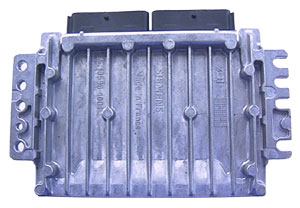Choice of functions that can be performed.
- Start Synchronization with immobiliser ECU: This causes the engine management ECU to go into Learn Mode where it will learn the next output from the immobiliser ECU and synchronize with it.
The synchronization procedure is done in three steps that should take place in one ignition cycling.
- Put the engine management in learning mode: This function is to be found in the engine management START SYNCHRONIZATION WITH IMMOBILISER ECU. The function will set the ECU into learning mode. Once you've been prompted that the engine management is in learning mode, navigate in the Vehicle Explorer to the immobiliser for step 2.
- Send code from immobiliser ECU: This function is to be found in the immobiliser SYNCRONIZE WITH ENGINE MANAGEMENT SYSTEM. This function will send codes to be learned. Once you've been prompted that the immobiliser sent the code successfully, navigate in the Vehicle Explorer to the engine management for step 3.
- Take the engine management out of learning mode: This function is to be found in the engine management END SYNCHRONIZATION WITH IMMOBILISER ECU. The function will end the learning mode, leaving the ECU in normal mode.
- End Synchronization with immobiliser ECU: This causes the engine management ECU to acknowledge the code sent by the immobiliser ECU and to exit Learn Mode.
- Reset All Adaptions: This procedure will reset the following adaptions: mass air flow, knock control, throttle position, idle control, oxygen sensor control, stepper motor lonr reset, misfire, dynamic trim.
- Reset Mass Air Flow Adaption: This adaption should be reset if any of the following components have been replaced or modified: Manifold pressure sensor, Inlet manifold or air leak was repaired, Inlet air temperature sensor, Connection to EMS 2000 ECU, or sensor ground to ECU.
- Reset Knock Sensor Adaption: This adaption should be reset if any of the following components have been replaced or modified: Any knock sensor, Connection to EMS 2000 ECU, or sensor ground to ECU.
- Reset Throttle Position Adaption: This adaption should be reset if any of the following components have been replaced or modified: Throttle position sensor, Connection to EMS 2000 ECU, or sensor ground to ECU.
- Reset Idle Control Adaption: This adaption should be reset if any of the following components have been replaced or modified: Idle control stepper motor, Throttle body, Manifold pressure sensor, Cylinder head, Inlet manifold or air leak was repaired, Inlet air temperature sensor, Connection to EMS 2000 ECU, or sensor ground to ECU.
- Reset Oxygen Sensor Adaption: This adaption should be reset if any of the following components have been replaced or modified: Oxygen sensor, Catalytic convertor, Exhaust system, Coolant temperature sensor, any of the induction system components, Cylinder head, Connection to EMS 2000 ECU, or sensor ground to ECU.
- Reset Stepper Motor Long Adaption: This adaption should be reset if any of the following components have been replaced or modified: Idle control stepper body, Throttle body, Connection to EMS 2000 ECU.
- Reset Misfire Adaption: This adaption should be reset if any misfire faults have been rectified.
|
 SM037 - SIEMENS EMS 2000 - System Help file
SM037 - SIEMENS EMS 2000 - System Help file SM037 - SIEMENS EMS 2000 - System Help file
SM037 - SIEMENS EMS 2000 - System Help file SIEMENS EMS 2000 - Known Fitments
SIEMENS EMS 2000 - Known Fitments SIEMENS EMS 2000 - Physical Details
SIEMENS EMS 2000 - Physical Details
 SIEMENS EMS 2000 - Pin Outs
SIEMENS EMS 2000 - Pin Outs SM037 - SIEMENS EMS 2000 - Diagnostic Capabilities (Read Fault Codes)
SM037 - SIEMENS EMS 2000 - Diagnostic Capabilities (Read Fault Codes) SM037 - SIEMENS EMS 2000 - Diagnostic Capabilities (Clear Fault Codes)
SM037 - SIEMENS EMS 2000 - Diagnostic Capabilities (Clear Fault Codes) SM037 - SIEMENS EMS 2000 - Diagnostic Capabilities (Settings)
SM037 - SIEMENS EMS 2000 - Diagnostic Capabilities (Settings) SM037 - SIEMENS EMS 2000 - Diagnostic Capabilities (Inputs)
SM037 - SIEMENS EMS 2000 - Diagnostic Capabilities (Inputs) SM037 - SIEMENS EMS 2000 - Diagnostic Capabilities (Outputs)
SM037 - SIEMENS EMS 2000 - Diagnostic Capabilities (Outputs) SM037 - SIEMENS EMS 2000 - Diagnostic Capabilities (Other)
SM037 - SIEMENS EMS 2000 - Diagnostic Capabilities (Other)